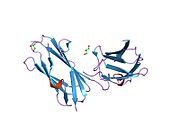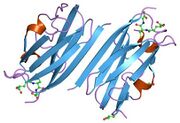Biology:FLNA
 Generic protein structure example |
Filamin A, alpha (FLNA) is a protein that in humans is encoded by the FLNA gene.[1][2]
Function
Actin-binding protein, or filamin, is a 280-kD protein that crosslinks actin filaments into orthogonal networks in cortical cytoplasm and participates in the anchoring of membrane proteins for the actin cytoskeleton. Remodeling of the cytoskeleton is central to the modulation of cell shape and migration. Filamin A, encoded by the FLNA gene, is a widely expressed filamin that regulates the reorganization of the actin cytoskeleton by interacting with integrins, transmembrane receptor complexes, and secondary messengers.[3] At least 31 disease-causing mutations in this gene have been discovered.[4]
Structure
The protein structure includes an actin binding N terminal domain, 24 internal repeats and 2 hinge regions.[5][6]
Interactions
Filamin has been shown to interact with:
- BRCA2,[7]
- CD29[8][9]
- CASR,[10][11]
- FBLIM1,[12]
- FILIP1,[13]
- FLNB,[14]
- NPHP1,[15]
- RALA,[16]
- SH2B3,[17]
- TRIO,[18] and
- VHL.[19][20]
RNA editing
The edited residue was previously recorded as a single nucleotide polymorphism(SNP) in dbSNP.
Type
A to I RNA editing is catalyzed by a family of adenosine deaminases acting on RNA (ADARs) that specifically recognize adenosines within double-stranded regions of pre-mRNAs and deaminate them to inosine. Inosines are recognised as guanosine by the cells translational machinery. There are three members of the ADAR family ADARs 1-3 with ADAR 1 and ADAR 2 being the only enzymatically active members.ADAR3 is thought to have a regulatory role in the brain. ADAR1 and ADAR 2 are widely expressed in tissues while ADAR 3 is restricted to the brain. The double stranded regions of RNA are formed by base-pairing between residues in a region complementary to the region of the editing site. This complementary region is usually found in a neighbouring intron but can also be located in an exonic sequence. The region that base pairs with the editing region is known as an Editing Complentary Sequence (ECS).
Site
The one editing site of FLNA pre-mRNA is located within amino acid 2341 of the final protein. The Glutamine (Q) codon is altered due to a site specific deamination of an adenosine at the editing site to an Arginine (R) codon. The editing region is predicted to form a double stranded region of 32 base pairs in length with a complementary sequence about 200 nucleotides downstream of the editing site. This ECS is found in an intronic sequence.[21] Editing at the Q/R site is likely to involve both ADAR1 and ADAR2.Mice ADAR2 knockouts show a decrease in editing at the Q/R site.ADAR1 double knockouts have no effect on editing.[22]
Structure
The edited adenosine is located in the 22 immunogloulin[check spelling] like repeat of the protein. This region is an integrin β binding domain[23] and a RAC1 binding domain.[16] The amino acid change is likely to effect the electrostatic potential of the binding domains.[21] FLNA editing site is 2 nucleotides from a splice site like the R/G site of GluR-2. Both transcripts have 7/8 identical nucleotides around their editing sites. Since it is widely thought that editing at the GLUR-2 Q/R site influences splicing, the sequence and editing site similarity could mean that editing at the FLNA site could also regulate splicing. In vitro experiments of gluR-2 have shown that presence of ADAR2 results in inhibition of splicing.[24] Analysis of EST data for FLNA show that there is a link between editing of the last exon codon and retention of the following intron.[21]
Function
The change in electrostatic potential is likely to effect the binding of FLNA to the many proteins it interacts with.[25]
References
- ↑ "Actin-binding protein (ABP-280) filamin gene (FLN) maps telomeric to the color vision locus (R/GCP) and centromeric to G6PD in Xq28". Genomics 17 (2): 496–8. October 1993. doi:10.1006/geno.1993.1354. PMID 8406501.
- ↑ "Localized mutations in the gene encoding the cytoskeletal protein filamin A cause diverse malformations in humans". Nat Genet 33 (4): 487–91. March 2003. doi:10.1038/ng1119. PMID 12612583.
- ↑ "Entrez Gene: FLNA filamin A, alpha (actin binding protein 280)". https://www.ncbi.nlm.nih.gov/sites/entrez?Db=gene&Cmd=ShowDetailView&TermToSearch=2316.
- ↑ "Refinement of evolutionary medicine predictions based on clinical evidence for the manifestations of Mendelian diseases". Scientific Reports 9 (1): 18577. December 2019. doi:10.1038/s41598-019-54976-4. PMID 31819097. Bibcode: 2019NatSR...918577S.
- ↑ "Relations between the electrical potential, pH gradient, proton flux and phosphorylation in the photosynthetic membrane". Biochimica et Biophysica Acta (BBA) - Bioenergetics 423 (2): 141–63. February 1976. doi:10.1016/0005-2728(76)90174-2. PMID 2316.
- ↑ "P21333 (FLNA_HUMAN): Filamin-A". UniProt. https://www.uniprot.org/uniprot/P21333#section_comments.
- ↑ "Interaction with BRCA2 suggests a role for filamin-1 (hsFLNa) in DNA damage response". J. Biol. Chem. 276 (51): 48318–24. December 2001. doi:10.1074/jbc.M102557200. PMID 11602572.
- ↑ "Different splice variants of filamin-B affect myogenesis, subcellular distribution, and determine binding to integrin [beta subunits"]. J. Cell Biol. 156 (2): 361–76. January 2002. doi:10.1083/jcb.200103037. PMID 11807098.
- ↑ "Filamin binds to the cytoplasmic domain of the beta1-integrin. Identification of amino acids responsible for this interaction". J. Biol. Chem. 273 (36): 23304–12. September 1998. doi:10.1074/jbc.273.36.23304. PMID 9722563.
- ↑ "Filamin-A binds to the carboxyl-terminal tail of the calcium-sensing receptor, an interaction that participates in CaR-mediated activation of mitogen-activated protein kinase". J. Biol. Chem. 276 (37): 34880–7. September 2001. doi:10.1074/jbc.M100784200. PMID 11390380.
- ↑ "Interaction of the calcium-sensing receptor and filamin, a potential scaffolding protein". J. Biol. Chem. 276 (37): 34871–9. September 2001. doi:10.1074/jbc.M100775200. PMID 11390379.
- ↑ "Migfilin and Mig-2 link focal adhesions to filamin and the actin cytoskeleton and function in cell shape modulation". Cell 113 (1): 37–47. April 2003. doi:10.1016/s0092-8674(03)00163-6. PMID 12679033.
- ↑ "Filamin A-interacting protein (FILIP) regulates cortical cell migration out of the ventricular zone". Nat. Cell Biol. 4 (7): 495–501. July 2002. doi:10.1038/ncb808. PMID 12055638.
- ↑ "Filamin A and Filamin B are co-expressed within neurons during periods of neuronal migration and can physically interact". Hum. Mol. Genet. 11 (23): 2845–54. November 2002. doi:10.1093/hmg/11.23.2845. PMID 12393796.
- ↑ "Nephrocystin-conserved domains involved in targeting to epithelial cell-cell junctions, interaction with filamins, and establishing cell polarity". J. Biol. Chem. 277 (32): 29028–35. August 2002. doi:10.1074/jbc.M111697200. PMID 12006559.
- ↑ 16.0 16.1 "The small GTPase RalA targets filamin to induce filopodia". Proc. Natl. Acad. Sci. U.S.A. 96 (5): 2122–8. March 1999. doi:10.1073/pnas.96.5.2122. PMID 10051605. Bibcode: 1999PNAS...96.2122O.
- ↑ "Identification of actin binding protein, ABP-280, as a binding partner of human Lnk adaptor protein". Mol. Immunol. 37 (10): 603–12. August 2000. doi:10.1016/s0161-5890(00)00070-5. PMID 11163396.
- ↑ "The Rac1- and RhoG-specific GEF domain of Trio targets filamin to remodel cytoskeletal actin". Nat. Cell Biol. 2 (12): 888–92. December 2000. doi:10.1038/35046533. PMID 11146652.
- ↑ "Identification of a novel protein (VBP-1) binding to the von Hippel-Lindau (VHL) tumor suppressor gene product". Cancer Res. 56 (13): 2881–5. July 1996. PMID 8674032.
- ↑ "The von Hippel-Lindau tumor suppressor stabilizes novel plant homeodomain protein Jade-1". J. Biol. Chem. 277 (42): 39887–98. October 2002. doi:10.1074/jbc.M205040200. PMID 12169691.
- ↑ 21.0 21.1 21.2 "Evolutionarily conserved human targets of adenosine to inosine RNA editing". Nucleic Acids Res. 33 (4): 1162–8. 2005. doi:10.1093/nar/gki239. PMID 15731336. Bibcode: 2005q.bio.....2045L.
- ↑ "Specificity of ADAR-mediated RNA editing in newly identified targets". RNA 14 (6): 1110–8. June 2008. doi:10.1261/rna.923308. PMID 18430892.
- ↑ "Interaction of filamin A with the integrin beta 7 cytoplasmic domain: role of alternative splicing and phosphorylation". FEBS Lett. 569 (1–3): 185–90. July 2004. doi:10.1016/j.febslet.2004.04.099. PMID 15225631.
- ↑ "Coordination of editing and splicing of glutamate receptor pre-mRNA". RNA 9 (3): 309–18. March 2003. doi:10.1261/rna.2750803. PMID 12592005.
- ↑ "Molecular structure of the rod domain of dictyostelium filamin". J. Mol. Biol. 342 (5): 1637–46. October 2004. doi:10.1016/j.jmb.2004.08.017. PMID 15364587.
Further reading
- "The evolution of filamin - a protein domain repeat perspective". Journal of Structural Biology 179 (3): 289–98. Sep 2012. doi:10.1016/j.jsb.2012.02.010. PMID 22414427.
- "Filamins as integrators of cell mechanics and signalling". Nat. Rev. Mol. Cell Biol. 2 (2): 138–45. 2001. doi:10.1038/35052082. PMID 11252955.
- "Structural and functional aspects of filamins". Biochim. Biophys. Acta 1538 (2–3): 99–117. 2001. doi:10.1016/S0167-4889(01)00072-6. PMID 11336782.
External links
- GeneReview/NCBI/NIH/UW entry on Otopalatodigital Spectrum Disorders
- GeneReviews/NIH/NCBI/UW entry on X-Linked Periventricular Heterotopia or Bilateral Periventricular Nodular Heterotopia
de:Filamin




